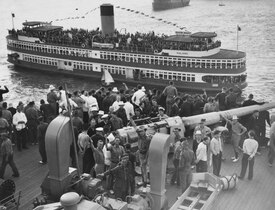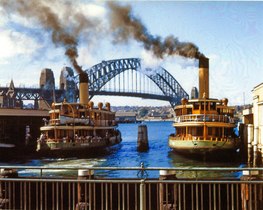
Sydney Harbour ferry services date back to the first years of Sydney's European settlement. Slow and sporadic boats ran along the Parramatta River from Sydney to Parramatta and served the agricultural settlements in between. By the mid-1830s, speculative ventures established regular services. From the late-nineteenth century the North Shore developed rapidly. A rail connection to Milsons Point took alighting ferry passengers up the North Shore line to Hornsby, New South Wales via North Sydney. Without a bridge connection, increasingly large fleets of steamers serviced the cross harbour routes and in the early twentieth century, Sydney Ferries Limited was the largest ferry operator in the world.
Contents
- Early days
- 1840s and 1850s
- 1860s and 1870s
- 1880s
- 1890s
- 1900s
- 1910s
- 1920s
- 1930s
- 1940s
- 1950s
- 1960s
- 1970s
- 1980s
- 1990s and 2000s
- 2010s and 2020s
- See also
- Notes
- References
However, arguably the most well-known is the Manly ferry service, and its large ship-like ferries that negotiate the beam swells of the Sydney Heads. From the mid-nineteenth century, the Port Jackson and Manly Steamship Company and its forerunners ran commuter and weekend excursion services to the beach-side suburb.
The 1932 opening of the Sydney Harbour Bridge dramatically and permanently changed Sydney Harbour. Sydney Ferries Limited annual patronage fell from 40 million to 15 million almost immediately. The hardships of the Great Depression and Second World War slowed the ferries' decline, but by 1951 the NSW State Government was forced to take over the ailing Sydney Ferries Limited. The Manly service fared better, and the Port Jackson company's peak year was 1946, after which a slow decline saw it too taken over by the NSW State Government in the 1970s. Ferry operations were privatised in 2015 with vessels and facilities remaining in public ownership.
Sydney's first ferries were sail and/or oar powered and by the mid-19th century, paddle steamers were well established. Double-ended ferries became common as they did not require turning at terminating wharves in Sydney's busy but narrow bays, including the main hub at Circular Quay. Double-ender ferries, however, provided technological challenges for screw (propeller) propulsion and Sydney's shift from paddle steamers to screw ferries in the closing years of the nineteenth century was relatively late. Diesel power first came to Sydney Harbour ferries mainly through the conversion of existing steam ferries to diesel in the 1930s and the 1950s, as ferry companies could generally not afford new ferries in the slow post-Bridge decades. Hydrofoils were introduced to the Manly run in the 1960s and 1970s halving travel times for those willing to pay a premium fare. Government investment in new vessels during the 1970s and 1980s saw the replacement of the surviving early twentieth century vessels. New vessels included modern Lady-class ferries, four large Manly ferries, and nine First-Fleet ferries. The most recent decades have seen the introduction of the RiverCats, JetCats, SuperCats and in 2017, the Emerald-class ferries. Apart from the four Manly "Freshwater-class" ferries, the current Sydney Ferries fleet comprises all catamarans.







































































